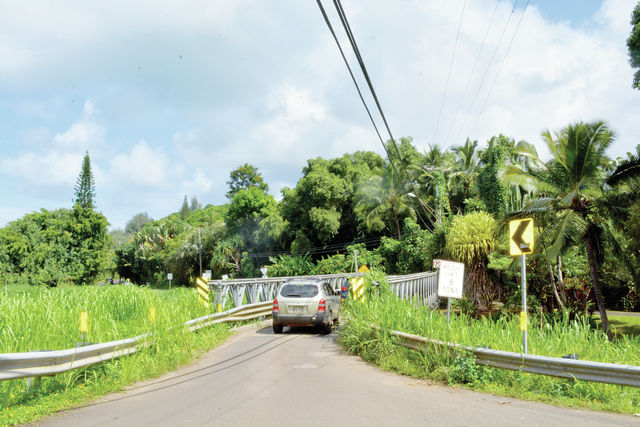WAINIHA — Christina Presley and her family moved to one of Kauai’s most rural hideaways six years ago for the peace and quiet. That, and the three little bridges with low weight limits. Haena’s only point of entry was a
WAINIHA — Christina Presley and her family moved to one of Kauai’s most rural hideaways six years ago for the peace and quiet.
That, and the three little bridges with low weight limits. Haena’s only point of entry was a sense of assurance that the neighborhood’s lazy, laid back character would endure.
“That’s exactly why we bought on this side of the island, because the trucks can’t get over here to build McMansions,” Presley said. “Because the trucks can’t get over here, period. We moved here for the solitude.”
But someday in the near future those very bridges that keep the grumbling trucks and heavy loads out of the area will start drawing them in. That’s because federal highway officials and the state Department of Transportation are in the process of designing a permanent replacement for Wainiha’s trio of historic one-lane bridges.
The lone gateway between Haena, Wainiha and Hanalei is on track to be upgraded to a series of concrete-based bridges, which are aesthetically similar to the current structures, only the profile is lower.
The project is estimated to cost between $15 and $25 million.
The three original bridges, located at mile 6 near the mouth of the Wainiha Stream before it feeds into Wainiha Bay, were actually temporary bridges built in the 1950s after a tsunami swept through the area. They were replaced with new temporary structures after the second bridge suffered permanent damage in 2004 and bridges one and three were determined to be structurally deficient in 2007.
The temporary bridges have allowed officials to buy time to develop a permanent solution.
No construction start date has been set because funding for the project has not been secured.
When construction does begin, it is slated to last two years. During this time, road delays will occur. Road closures will be necessary at project milestones. And the big, grumbling trucks that are normally off-limits to the western edge of the developed North Shore will need to find ways to start coming in.
Temporary bridges may need to be built side-by-side or up-and-over the Waiolo, Waikoko and Waipa bridges in order to accommodate heavy construction loads that these existing bridges may not be equipped to handle.
During past road closures associated with Wainiha bridge construction events, state officials have provided a boat shuttle for people needing to travel to homes and business appointments west of the bridges.
The proposal for the Wainiha bridge replacement is being refined by project keepers for a detailed analysis of the engineering design and environmental compliance. They are also waiting for funding.
“Availability of construction funding is dependent on how this project compares to other statewide priorities for HDOT,” said Michael Will, a construction operations engineer for the Federal Highway Administration.
If officials decide that the Wainiha project is a priority when compared to the projects across the state, construction will kick off sooner than later. Otherwise, there will be a wait.
Once funding is identified, project leaders will be able to assemble a timeline for construction.
Construction costs are dependent on market conditions such as material costs and the availability of a bidder.
Apart from the hunt for funding, the next step in the process requires officials to prepare a draft environmental statement on which the public will have the chance to review and comment on.
This is the aspect of the project that is most concerning to Presley.
“From a personal standpoint, if I’m inconvenienced by (the construction), it doesn’t matter,” she said. “I’m more concerned about the environmental impact.”
Presley said she wonders how the construction might affect the flow of water where the mouth of Wainiha Stream lets out into the open ocean.
Kira Hawkins, who needs to cross the bridges to get from her home in Haena to her job at Kalalau Trail Outfitters in Wainiha, said she fears the project will be one great interruption to her daily routine.
“You want them to be safe,” the 23-year-old said of the bridges, “but you don’t want to be bothered.”
She paused for a moment.
“Actually, I’m going to Europe soon,” she said. “Maybe I’ll miss the whole thing.”
•••
Brittany Lyte, environmental reporter, can be reached at 245-0441.


